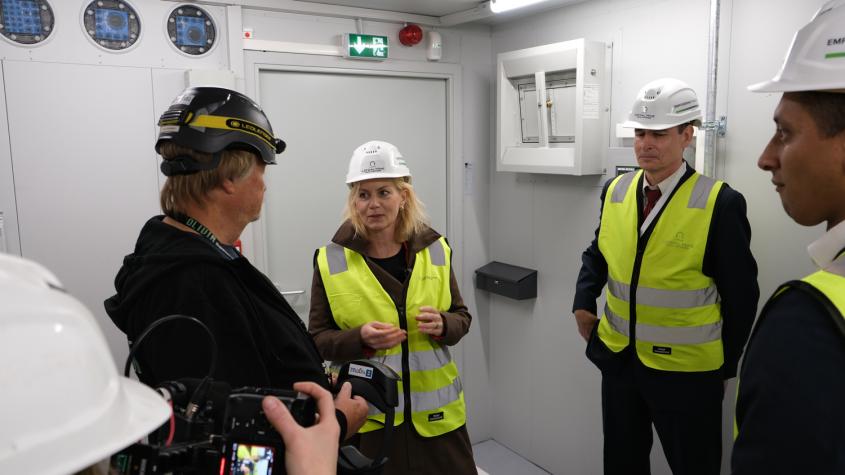A new generation of the NIRD Research Data Archive, Norway's national archive for storing research data, is now being launched.
This will be Norway’s largest and most comprehensive archive for storing scientific data to date. The archive aims to position Norway as a leader in open research and data sharing.

A secure haven for the research of tomorrow
The NIRD Research Data Archive already contains more than 800 datasets, including climate data used in UN climate reports and Nobel Prize-winning data from the Moser group’s brain research. Nobel Laureate May-Britt Moser states:

—To map the brain's functions, we need as many researchers as possible to participate. By storing data in the NIRD Research Data Archive, it becomes accessible to researchers worldwide, who can use it to investigate new hypotheses. This streamlines research, involves more people, and minimizes resource use and animal testing.
—The NIRD Research Data Archive can accelerate research processes by enabling researchers to build on existing data and results, strengthening interdisciplinary collaboration and playing a key role in innovation, especially in artificial intelligence and big data analysis. Open data sharing also promotes ethical research by reusing data from animal experiments or environmental testing, says Moser.
Collaboration, Sharing, and Protecting Data
Proper storage of data after research projects conclude ensures secure preservation over time, promotes transparency and collaboration across disciplines, and adheres to key principles of open research. To maximize the utility of the data, it must be easy for anyone to retrieve it from the archive.
Safeguarding data storage, regardless of changing political priorities, is essential for preserving knowledge for future generations. The NIRD Research Data Archive is a crucial part of Norway's efforts to protect research data from political and institutional changes and to preserve it for the future. Recently, the government proposed strengthening Norway's capacity for research data storage by increasing funding to Sigma2 by NOK 20.2 million in the revised national budget.

A robust, user-friendly archive

— We are proud to launch a new research data archive that will make it easier to share and reuse data. This strengthens Norway’s role in open science, says Lorand Szentannai, Head of Data and Storage Services at Sigma2.
— The new solution is developed focusing on user-friendliness, robust systems, and seamless API support. The archive can efficiently manage metadata and store millions of datasets, equivalent to several petabytes of valuable research data.
Sigma2 offers a secure and reliable national solution for storing and sharing research data. The goal is to facilitate collaboration and innovation across disciplines while safeguarding data against political agendas and institutional shifts.
The archive is freely available to researchers and approved research projects, allowing them to upload their data. The data can also be downloaded anonymously and openly by industry and the public.
About NIRD Research Data Archive
The NIRD Research Data Archive is Norway’s largest archive for scientific data, designed for long-term storage and sharing of research data. It follows the OAIS model (Open Archival Information System) and supports the FAIR principles (Findable, Accessible, Interoperable, Reusable). This means the data is stored according to international standards that ensure high data quality, transparency, accessibility, interoperability with other systems, and reusability.
A rich set of APIs makes the archived datasets available to other research and library systems, improving metadata harvesting and increasing the archive’s relevance nationally and internationally. The archive is built on the robust and scalable CKAN data platform, creating a more open, transparent, and efficient infrastructure for research data.

CoreTrustSeal approved
The NIRD Research Data Archive has been certified as a Trustworthy Data Repository by the CoreTrustSeal standards, affirming its steady commitment to data stewardship. This international endorsement underscores that NIRD Research Data Archive adheres to crucial standards for data preservation, accessibility, and reliability, reflecting Sigma2’s dedication to safeguarding valuable datasets for the research community.
— The certification demonstrates our commitment to secure and long-term preservation of research data, for the benefit of Norwegian and international researchers, says Lorand.
Real users, notably Lara Ferrighi and Anne Fouilloux, have played a pivotal role in this project.
Their expertise has been essential in shaping the new archive to meet practical needs and international standards. Lara Ferrighi, Senior Research Scientist at the Norwegian Meteorological Institute, highlights the creation of a metadata model designed to be interoperable with global standards, facilitating easier access and interface with other infrastructures.
Anne Fouilloux, Senior Research Engineer at Simula, emphasized aligning the project with long-term objectives. She ensured the development by Datopian supported the NIRD archive's evolution according to FAIR principles and Open Science standards.
Key features and improvements
User-centred design
The initial design phase prioritised a user-centred methodology, incorporating end-user feedback early on. This approach led to the creation of mock-ups and prototypes that provided valuable insights into the researchers' needs and challenges.
Integration of emerging technologies
One of the standout features is the integration of Reseach Object Crate (RO-Crate), a technology that makes datasets machine-interpretable. This aligns with the FAIR (Findable, Accessible, Interoperable, Reusable) principles, significantly enhancing the discoverability, reusability, and interoperability of the data stored in the archive.
Flexible and long-term storage
All data will be accessible via S3 protocol, enabling flexible storage data access, seamless interaction with the long-term archive through APIs, and the creation of Analysis-Ready Cloud-Optimised Datasets. This shift from merely dumping data to depositing it for future reuse is particularly beneficial for fields like bio-imaging and Earth observation, ensuring continuous access to up-to-date data.
Enhanced Performance and Reliability
The new archive solution addresses several performance issues identified in the current system. The web interface for uploading data has been optimised for large datasets, and the system now supports fault-tolerant uploads, allowing researchers to resume uploads from the last successful file.
Modular and Composable Service
The archive service has been restructured into smaller, composable components, allowing for greater flexibility and easier updates. This modular approach ensures that changes to one part of the system do not impact the entire service, making it more adaptable to future needs.